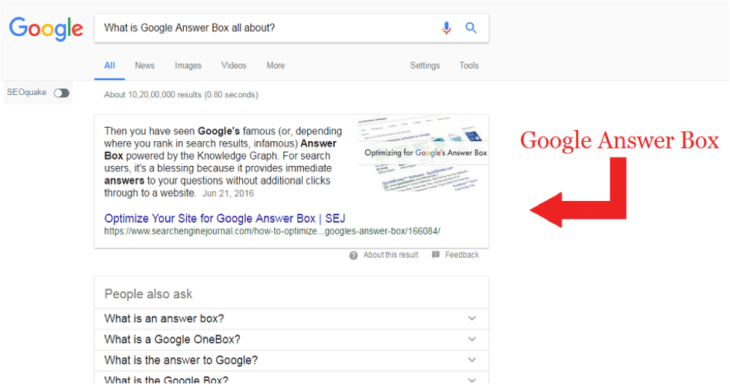2019 has proved that to get to the top, websites will need extra to pull off what it takes to drive traffic, rank high, command conversion rates, and engage customers.
One of the significant things websites will need to do to stay on top is to improve local SEO. Instead of general keywords like SEO Company, Google will quickly pick up a company with a local keyword. Besides improving local SEO, here are the three major tips you need to apply in the second half of 2019.
Savior content

Source: Pixel Productions Inc.
Have you noticed how Google displays sneak peek answers to your query when you do a search?
It’s called the Google answer box. It contains the text of the most relevant answer to your search query and the URL of the site that has the answer to the question. For the rest of this year, you need to make your content relevant and useful enough so that it can fit in Google’s answer box.
Let’s do the math. Google receives 5.6 billion search queries a day. If your content is one of those in the Google answer box, even if you receive just 1% visits from the 5.6 billion, you will enjoy numerous traffic.
So to get into Google answer box, here is what you should do: conduct keyword research and come up with useful content. Make sure your content is crafted in a way that answers the Google answer box in a concise and clear structure. And don’t forget to optimize your content. But that’s not all you have to do to provide savior content. Only answering Google answer Box would be like cooking chicken sauce without the ingredients.
So go back to the rules of good content creation and add these ingredients to your savior content.
These are:
- Content that offers answers to questions readers come looking for
- Well sourced content with relevant links and expert advice where possible
- Great titles that pull a reader by the arm and make them stick
- Engaging and thoughtful articles that spark conversations after your content is out there.
- Striking images for visual enjoyment but also to draw attention and further explain your content
- Adding continued updates to your content
Mobile optimization

Source: Crazy Egg
Mobile optimization is where a website re-arranges its content, images, and buttons to fit well on any device. Be it a mobile phone, a laptop or a tablet. It’s similar to a mobile-friendly website except that with a mobile-friendly website, the content displays correctly on any device without formatting itself.
According to Google, 50% of all search queries are done by mobile devices. Also by early 2019, Mobile devices contributed to 48.71% of Google’s PPC ads and 33% of Bing.
That tells us something. Mobile optimization is a must-have!
I probably fall under the 50% Google search query users. I only search Google on my laptop while at work-5hours a day. The rest of my searching is done on my phone; and trust me, if I open a site, and it’s not mobile-optimized, I will move on to a mobile-friendly site without wasting no time.
Just like me, studies suggest that many consumers will walk away from a shop if they open the shop’s site to clarify something and have a hard time using the site. They may not make a quick buying decision or will get off the site and not buy at all.
So optimizing a site is very important.
Have an organized web design with buttons in the right places. Please don’t have ads popping up from every corner.
Make sure your site loads fast and update its page titles often. I know many websites that disregard mobile optimization, but with the increased mobile users in this age, you just don’t know how many customers you lose simply because they couldn’t reach your website using a mobile handset.
And don’t forget that four years ago, Google started considering mobile-friendliness as a factor in ranking.
Voice search

Source: onlinemarketinginstitute.org
So far, 40% of Google searchers use voice search, and it is estimated that by 2024, 50% of all searches will come from voice. Voice search is huge, and it’s here to stay.
People love giving voice commands because it’s easier and cool. I mean, isn’t it cool to ask Google or Siri or Cortena for anything and get a voice answer while you drive or while you work on your laptop? I think it is.
What’s can more impressive is that it’s faster – you can speak faster than you can type.
So how do you get your website on voice search?
You will need to get smarter with your keywords to target voice search users. As you can imagine, people asking questions with speech will use words like, “Where”, “What”, “how”, “types”, “when”, “can”, “I”, “easy”, “new”, “free”, and the many others.
For example, a voice search query could go like this, “I need the best shoe stores in California” Or “Can I know where Mcdonalds Eindhoven is located?”
SEO expert Tom McSherry of https://www.premiumseo.co.nz advice to create long-tail question keywords rather than the short ones. He explained that in voice search, people ask questions like, “Google, which is the best country for sunshine destinations?”. Which becomes a longtail keyword
Conclusion
If you are not sure how to go about with any of the above tips, it’s better to hire an expert to do the work for you. If you decide to hoop on the journey by yourself, you must know that it takes blood, sweat, and tears to rank well or even to drive considerable traffic. But it’s all worth it.
Qn: What did you do for SEO in the past six months of 2019? Let’s share in the comments
